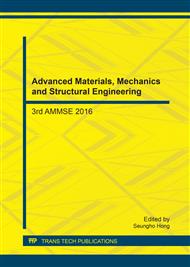[1]
W. L. Chen, Difference of Dry- mixed Mortar from Traditional Mortar and Its Developing Potential, Anhui Archit. 3 (2009) 71-72.
Google Scholar
[2]
L. Q. Quan, D. X. Li, Research on performance of cement - based self- leveling material containing fly ash, Concr. 12 (2007) 48-51.
Google Scholar
[3]
L. Q. Huo, Study on the effect of gypsum on the performance of cement -based self-leveling mortar, New Build. Mater. 43 (2016) 81-84.
Google Scholar
[4]
H. Chen, M. Tang, Research on the performance of self-leveling mortar with high content of fly ash, Build. Tech. Dev. 6 (2004) 53-55.
Google Scholar
[5]
C. L. Liu, Preparation of cement-based self-leveling mortar, China Coat. 23 (2008) 41-44.
Google Scholar
[6]
X. F. Shen, Key points of construction technology for epoxy self-flowing smooth floor, Archit. Tech. 34 (2003) 66-67.
Google Scholar
[7]
F. Xu, L. H. Chen, W. P. Cai, Floor coating and self-leveling mortar material, Chem. Ind. Press. (2008) 1-25.
Google Scholar
[8]
S. N. Tian, Development status of cement based self leveling mortar for the ground, Fujian Archit. Mater. 2 (2010) 5-6.
Google Scholar
[9]
S. Lu, Z. Wang, Y. Zhang, Shrinkage performance of cement mortar related to adding of additive, Low Temp. Archit. Tech. 4 (2007) 4-6.
Google Scholar
[10]
W. H. Zhong, C. R. Lu, The effect of shrinkage reducing agent on the shrinkage performance of the cement based materials, Shanxi Archit. 31 (2005) 1-2.
Google Scholar
[11]
S. Parviz, M. Faiz, A. Abdulrahman. Plastic shrinkage of polypropylene fiber reinforced concrete. ACI Mater. J. 92 (1995) 553-560.
Google Scholar
[12]
G. Miroslaw, P. S. Surendra, Shrinkage cracking of fibre reinforced concrete. ACI Mater. J. 87 (1990) 138-148.
Google Scholar
[13]
J. G. Du, Development and Study on the Properties of YD Flowing Agenfor the Self-leveling Mortar, J. Build. Mater. 3 (2000) 37-41.
Google Scholar
[14]
J. L. Bu, Development of floor surface self leveling material, Chem. Build. Mater. 9 (2003) 30-32.
Google Scholar
[15]
K. S. Xu, Development situation of cementitious self-leveling material, Jiangsu Archit. Mater. 4 (2010) 28-30.
Google Scholar
[16]
Z. Z. Ren, F. Wu, Study of dispersible polymer powders on cement-based self-leveling mortar performance, New Build. Mater. 43 (2016) 100-103.
Google Scholar
[17]
J. M. Guo, H. H. Cao, Experiment and study on mechanical properties of redisperse emulsion powder mortar, Highway. 1 (2008) 160-165.
Google Scholar


